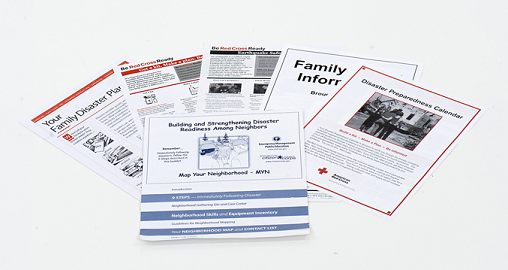How to Set Up and Run a Map Your Neighborhood Program Where You Live
I decided to run this program in my neighborhood, and decided to provide you with my personal experience and resources that will make it easier for you to do it too! But what is it? Why do it? Keep reading.
What is it? “Map Your Neighborhood” is a program designed to help neighborhoods prepare for disasters. With it you can increase your odds of survival in a disaster. It covers these topics and more:
- The 9 steps you should take immediately following a disaster
- How to identify skills and equipment available in the neighborhood
- How to create a neighborhood map
- What should be in your contact list
- How your and your neighbors can start working together as a team! (If nothing else, you’ll know who you can go to for help, versus who will probably need help.)
Why do it? As you can see in one of my first CERT classes, the question is raised – “What can I do about helping my neighbors?” And I add the second part of the question – “So that they can take care of themselves versus relying on my resources?” In addition, you may have neighbors with special needs, and these should certainly be identified before an emergency.
Here are the steps I followed to Map My Neighborhood:
- Find materials
- Check for general interest with neighbors
- Send out invitations (invited in person and with paper taped to doors)
- Prepare some examples of kits, etc.
- Get dessert ready (added incentive for those who need a little more motivation :-))
- Make a map to hand out
- Get some additional materials from my local American Red Cross
Finding the educational materials wasn’t as simple as I thought it should be. I had to look around for a couple weeks to find what I needed. Although some resources were available online for download, there was no clear description of what specific resources were actually needed to do the training. And when I did eventually determine what materials were needed (it took a couple phone calls), I wasn’t able to find them in one place.
How did I do it? We don’t have this program in my city, so I didn’t have a local contact. I tried the county emergency management office, and found nothing. I tried the state, and they put a DVD in the email for me, along with one sample handout. At the time, I didn’t ask for more copies, although I probably could have.
And then, since I was taking a CERT course in a neighboring city (since my city also doesn’t do CERT :-(), I asked about finding the Map Your Neighborhood student handouts and found some. You may need to be creative, and don’t hesitate to check with neighboring emergency management offices! People in these roles are usually (and certainly should always be) very helpful and generous with educational resources.
Here are the materials you need to run the Map Your Neighborhood program:
- Attendee/Student handouts: I had to get these locally from a neighboring city’s emergency management office, since my city’s office couldn’t help for whatever reason.
- Training DVD: I had to get this from the state emergency management office. I may have been able to get a copy locally, but I didn’t know who to ask at the time. This will give some useful tips, but as you will be able to see later, I didn’t use it directly in my presentation. I probably broke the rules there, so don’t tell anyone.
- Instructor discussion guide/manual: I downloaded the discussion guide here: http://www.emd.wa.gov/myn/documents/myn_discussion_guide.PDF. (Thanks to Washington State Military Department Emergency Management Division for making this available!
- Anything else you want to give out: I found good handouts from my regional American Red Cross on disaster preparedness and more. I suggest you go to your local chapter and ask for some materials to give y our neighbors. You’ll probably walk away with your hands full.

Additional materials are available here: http://www.emd.wa.gov/myn/myn_resources.shtml
I reviewed the video, handouts, and teacher’s guide ahead-of-time. The good news – I learned a couple things. That’s the great thing about teaching/guiding a group – it’ll force you to learn things yourself!
Now that I knew the basic curriculum, I knew how to summarize with neighbors over the next week. Whenever I saw one of them, I mentioned “Expect an invitation taped to your door soon, for the disaster preparedness program we’ll be running at our house. It won’t take long and you’ll learn something!” I also tried to get a feel for when they would be available, so that I could propose a time/date that would get the best attendance.
One of the neighbors was clearly interested in what it was about, so I gave a few more details. Aside from wanting to help him out with the information, I wanted to gauge his reaction, so I’d have a better idea how other neighbors would react. He was quite interested, and also didn’t know how to do some of the things we discuss, e.g., turn off his natural gas line. Just the type of student I’m looking forward to working with!
Later that week, I finished drafting and printed out a “Howdy Neighbors” letter, and handed it to the neighbors in person in the evening, or taped it to the door of the couple that weren’t home.
I got a variety of responses:
- “Great, looking forward to it.”
- “Thanks, this is a good thing you’re doing”, and shook my hand. He appeared to be very interested. Later I learned otherwise (see Part 2.)
- “Yeah, OK”, and shut the door quickly. Maybe I was interrupting dinner…
- “Great.” Short and sweet. I knew this guy was already well-prepared.
I had a few concerns at this point. Could I get them to show up? Can I fit them in our living room? Can I keep them comfortable? Will they find the material interesting? Will they ask a bunch of questions I don’t have answers to? And worst of all, by doing this, would they now view me as their “disaster plan” for an emergency, instead of preparing for themselves?
Do you want a template to use for your neighborhood? Free for my readers – you can use this one or modify it as you see fit: download doc here. Simplly fill in the [bracketed] areas and you your own, personalized letter, ready to go.
To see how the meeting went, read Part 2! (coming soon :-))
Stay safe,
Andrew

Very good information. Our Citie’s CERT’s are also going through a push to roll MYN out to our neighborhoods. You have provided soem good points to consider and soem good reference materials worth sharing.
Looking forward to part 2…
Ed
Thanks Ed, glad to hear you found it useful. I’m working on Part 2 now, and you can expect it soon! 🙂